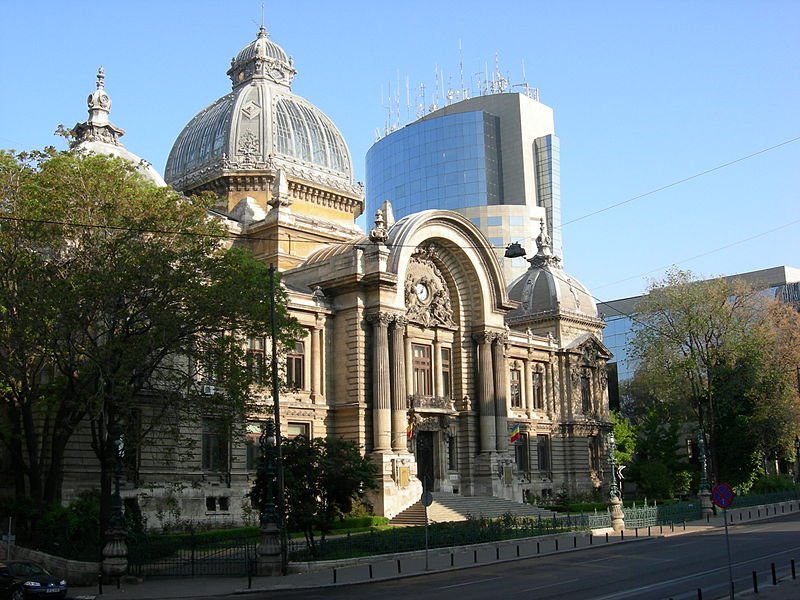 Postavaru Mountain, Romania, in winter
Postavaru Mountain, Romania, in winterSource: https://commons.wikimedia.org/wiki/Category:Snowy_landscapes_in_Romania#/media/File:White_Valley.jpg
Author: Marinescu Dan

Romania is a country that can be considered to be between Southeastern Europe and Central Europe. Romania is on the northern part of the Balkan Peninsula. It is on the Lower Danube, and includes the Danube Delta, and it has a coastline to the Black Sea.
Covering 238,391 sq km (92,043 sq mi), Romania is bordered by Ukraine to the north, Moldova to the northeast, Bulgaria to the south, Serbia to the southwest, and Hungary to the west.
 CEC (Casa de Economii şi Consemnatiuni) Building, Bucharest
CEC (Casa de Economii şi Consemnatiuni) Building, BucharestSource: https://commons.wikimedia.org/wiki/File:Bucharest_CEC_4.jpg
Author: Joe Mabel

Romania is today a republic with a president and a prime minister. It has a population of 22 million people. Its capital and largest city is Bucharest. The official language is Romanian, and 89.5% of the population count themselves as ethnic Romanians. The official currency is the Romanian leu (RON). Traffic is driven on the right here. The country observes the Eastern European Time, which is two hours ahead of Coordinated Universal Time (UTC+2) and three hours in summer. The phone IDD code is +40.
Romania has an estimated nominal GDP of $158.4 billion in 2010, or a per capital nominal GDP of $7,391. Its per capita GDP at purchasing power parity stood at $11,767.
 Bran Castle, better known as Dracula's Castle, in Romania
Bran Castle, better known as Dracula's Castle, in RomaniaSource: https://commons.wikimedia.org/wiki/File:Bran_23.jpg
Author: Pomponius

Romania is the ninth largest country in the European Union and the twelfth largest in Europe. It has a fair share of lowlands and mountain ranges. The highest peak in Romania is Moldoveanu Peak, at 2,544 m (8,346 ft). The Danube River flows through Romania before emptying into the Black Sea, fanning out into the Danube Delta as it does.
Romania's climate is transitional between temperate and continental. Summers are very warm to hot, with temperatures over 35°C (95°F) quite common in Bucharest between June and August. Springs are cool, especially in the morning. Winters can be cold, about 2°C (36°F) in the cities, and as low as -15°C (5°F) in the high mountains.
Romania has been inhabited for thousands of years - the oldest human remains discovered in Romania are 42,000 years old, being the oldest remains of Homo sapiens in Europe. An area called Dacia, which corresponds to present-day Romania, was settled by Getae tribes in 330 BC. The area was conquered by the Roman Empire in the Dacian War (87-106 AD).
 Great Church in Sinaia Monastery, Romania
Great Church in Sinaia Monastery, RomaniaSource: https://commons.wikimedia.org/wiki/File:Sinaia_monastery_-_the_Great_Church.jpg
Author: Pudelek

After the Romans pulled out of Dacia, the area was invaded by various tribes including the Goths, the Huns, the Gepids, the Avars, the Bulgars, the Pechenegs and the Cumans. By the Middle Ages, Romania comprised three districts namely Wallachia, Moldavia and Transylvania. By 1541, almost the whole Balkan peninsula including Wallachia, Moldavia and Transylvania were under the Ottomans.
In 1699, Transylvania became a territory of the Austrian empire, which expanded in 1718 to inlcude part of Wallachia while the Moldavian principality was occupied by Russia from 1812.
The Soviet occupied Romania after the Second World War, and the Communist dominated the government. They forced King Michael I to abdicate and turned Romania into a people's republic. Romanian resources were exploited by the Soviet Union during this period, as private firms were nationalized and Soviet-Romanian companies set up to tap the natural resources.
 The Silver Knife Church, Bucharest
The Silver Knife Church, BucharestSource: https://commons.wikimedia.org/wiki/File:Biserica_Cutitul_de_Argint.jpg
Author: Gabriel

Nicolae Ceau&3351;escu came to power in 1965 and in the initial years pursued independent policies. But by the 1970's, Romania's foreign debt forced Ceau&3351;escu to take austerity steps that impoverished the Romanian people, while at the same time imposing a cult of personality. His dramatic decline in popularity culminated with his overthrow and execution in the Romanian Revolution of 1989.
Today Romania is a multi-party democracy. The country joined NATO on 29 March 2004. It became a member of the European Union on 1 January 2007.
Planning your visit to Romania
Romania is a member of the Schengen Agreement but has not fully implemented it. Visitors from EU and EFTA countries only need an approved ID card to enter Romania. From other countries, visitors who do not need a visa include the citizens of Albania, Andorra, Antigua and Barbuda, Argentina, Australia, Bahamas, Barbados, Bosnia and Herzegovina, Brazil, Brunei, Canada, Chile, Costa Rica, Croatia, El Salvador, Guatemala, Honduras, Hong Kong, Israel, Japan, Macedonia, Malaysia, Mauritius, Mexico, Monaco, Montenegro, New Zealand, Nicaragua, Panama, Paraguay, Saint Kitts and Nevis, Seychelles, Singapore, South Korea, Taiwan, United States, Uruguay, Vatican City and Venezuela. Bicaz Canyon, Romania
Bicaz Canyon, RomaniaSource: https://commons.wikimedia.org/wiki/File:Chei_Bicaz_047.jpg
Author: Laurap

The Henri Coandă International Airport, also called the Bucharest Otopeni International Airport (OTP) is the bigger of the two airports serving Bucharest. The other, older airport is the Băneasa International Airport (BBU). The Otopeni airport serves major cities in Europe and the Middle East. The Băneasa airport is served mostly by low-cost carriers such as Blue Air and Wizz Air.
Preparing Money for your trip to Romania
The currency used in Romania is the Romanian Leu (RON).Major Cities in Romania
- Bucharest - capital
- Braşov
- Cluj-Napoca
- Constanţa
- Iaşi
- Sibiu
- Sighişoara
- Suceava
- Timişoara
Places of Interest in Romania
- Black Sea Resorts
- Carpathian Mountains
- Painted Monasteries
- Transylvanian Alps
 Latest updates on Penang Travel Tips
Latest updates on Penang Travel Tips

Copyright © 2003-2025 Timothy Tye. All Rights Reserved.

 Go Back
Go Back